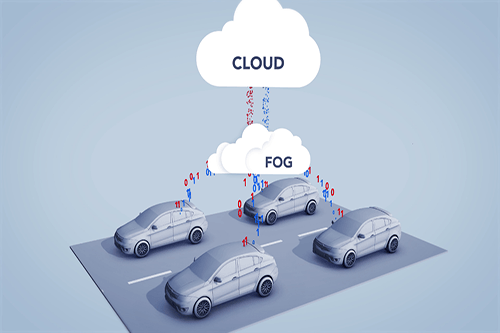May 14 2019
A multi-organizational team has recently commemorated the completion of three years of combined research and development with the release of its latest findings. The team is behind the £5.5 million FLOURISH connected and autonomous vehicle (CAV) project.
 ‘Fog technology’, designed by researchers in the University's Faculty of Engineering, is an innovative computing infrastructure that could be fundamental in allowing CAVs to be safer and more efficient. (Image credit: University of Bristol)
‘Fog technology’, designed by researchers in the University's Faculty of Engineering, is an innovative computing infrastructure that could be fundamental in allowing CAVs to be safer and more efficient. (Image credit: University of Bristol)
Such findings concentrate on connectivity and data and consider how data can be exploited to improve the road network functionality and thus offer an improved user experience.
Throughout the last three years, the FLOURISH team has been committed to exploring how innovative new technologies can be used to keep our cities moving and people connected. With the user of the future in mind, we have explored the technology required to realise this vision. This thinking has informed our investigations into the safe operation of a network of driverless vehicles in a connected smart city environment—which is crucial if we are to achieve the full benefits of this technology, for all. It has also been a key driver of our engagement with older adults and those with mobility-related conditions. The benefits of CAVs include enhanced, inclusive and personalised mobility, increased capacity on our road network and improved air quality.
Tracey Poole, FLOURISH Project Manager and Transport Planning Specialist, Atkins
Atkins is a member of the SNC-Lavalin group.
Data and connectivity
The FLOURISH car trials have examined the needs for the secure, effective, and robust transfer of information between vehicles and with the cyber-physical infrastructure surrounding them.
Furthermore, FLOURISH partner is the award-winning Communications Systems and Networks (CSN) Research Group at the Smart Internet Lab of the University of Bristol. It was the first to develop the application of Fog-Based Computing to CAVs, offering a mechanism for transferring data between the network and vehicles in real time. Faster than cloud-based solutions, this new, revolutionary technology allows vehicles—and fleets of vehicles—to react to varying road and traffic conditions and guarantees the origin of the data source.
Fog-Based Computing is a state-of-the-art new technology which has the potential to deliver huge benefits to those who plan the provision of transport in our cities and for those who rely on our road network. It gives a clear road map for how driverless cars can be operated, with agility and safety built into the DNA of a network.
Robert Piechocki, Professor of Wireless Systems, University of Bristol
Simulated environments were also utilized by FLOURISH to investigate how Artificial Intelligence can be leveraged in traffic management systems in order to generate a responsive CAV network. This would allow the CAV network to respond to variations in conditions—like volume of traffic, weather, or an accident—rapidly and reroute journeys through real-time traffic and vehicle data to securely navigate the most optimized route.
In addition, the project has examined the possibilities for autonomous and connected to interact with one another and the surrounding infrastructure utilizing frequencies usually related to Wi-Fi. Often seen as an enabler of indoor connectivity, its low frequencies can make it possible to effectively transmit data for longer distances.
Secure and cyber-resilient communications
In order to preserve the service availability and integrity of wireless communications between physical and digital assets, the FLOURISH team has created an Incident Response Framework. This framework enables incidents that could affect the performance or undermine the integrity of both the network and vehicle, to be recognized and evaluated for the level of danger posed by them. It offers a set of principles, based on scenario development, for managing a response to a host of safety incidents. Scenarios like these can range from intentional interference with vehicle-to-infrastructure and vehicle-to-vehicle communications, to signal accidental failures and jamming.
If we are to deliver the transformative benefits of CAVs, it is absolutely essential that the public is confident in the ability of the technology to respond to a range of potential scenarios and select the appropriate response to keep users safe.
Christian Compton, Cyber-Security Expert, Atkins
The user experience
The technology—a comprehensive approach for designing the human machine interface (HMI) —through which users will communicate with the CAV has been vital to FLOURISH. All through the course of the project, a sequence of growingly intricate, simulated and real-world trial scenarios have evaluated what older people will need to be able to assuredly engage with autonomous vehicles. This has led to the development of a Standardized Assessment Framework, or SAF, which ascertains best practice for evaluating the users’ requirements and connecting their specific needs to design preferences.
If we are to successfully introduce CAVs onto the UK’s roads, then it is essential that we listen to what people want from this technology. The creation of the Standardised Assessment Framework shows that we are doing just that.
Chris Alford, Associate Professor, Applied Psychology, University of the West of England
For next-generation users to have confidence in autonomous vehicles, it is equally important that the regulatory environment enables the seamless introduction of CAVs and, at the same time, safeguard the privacy of people. The new study from the FLOURISH legal and insurance partners has concentrated on the General Data Protection Regulation and what exactly it means for people in a data-connected transport system.
FLOURISH - The Benefits of Connectivity
Video credit: University of Bristol